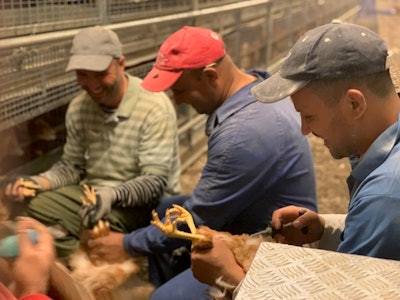
In the second quarter of 2019, Mexico reported 18 outbreaks with H7N3 avian influenza isolates in six different reports to the World Organisation for Animal Health (OIE). In the last ones of that quarter, the Mexican National Service of Agri-food Health, Safety, and Quality (Senasica) reported 1,000 affected birds in an outbreak in the state of Hidalgo, 210 in Jalisco, and 50 in Guanajuato. All of those were backyard birds.
How important can this amount of birds be for the second-largest broiler producer in Latin America, which in 2018 produced 1.837 billion broilers and had 163 million layers in production?
In the first instance, it would seem that it is not important, given the disparities between the affected birds and the poultry production in the country, in addition to them being backyard birds.
So why is this done? In the search for the reasons, one of the facts that stands out is the change of public administration that took place at the end of 2018 in Mexico. After that, the way of doing things and how to inform the public became different. The new government “wants total transparency,” said Dr. Roberto Señas, director of Health, Regulation and Poultry Quality of the National Poultry Producers Association (UNA, in Spanish) of Mexico.
In contrast, in previous governments, diseases reports were considered a matter of national security. First, the data was evaluated internally and based on that the situation was then reported. “Now, although of being of national security, it has to be reported,” even if the outbreak happens in a remote site and only affects a few backyard chickens, continued Dr. Señas.
Epidemiological surveillance and politics
So many reports could lead to questioning whether avian flu is resurfacing in Mexico. Nevertheless, it does not seem to be the case. Plain and simple, it is an epidemiological surveillance finding. “It is an effort of the federal government, and every finding has a reason, it is important, and it must be reported,” regardless of the repercussions. It must be recalled that there are epidemiological findings in all countries of the world.
Dr. Señas clarifies, however, that “the current government strategy must be accompanied by a communication strategy.” The epidemiological surveillance findings show that things are being done well. We must emphasize this because it does not imply that the whole country has animal health problems. The authorities search for the disease passively and actively, and when they find it, they take actions as in any quality management system.
In terms of the communication strategy, when the authorities find an outbreak they should say they carried out all the national and international actions in the legal framework. They should emphasize that the outbreak was resolved, that it was monitored again and that it was verified that there were no problems, so as to close the case.
At UNA, they are aware that epidemiological surveillance is essential, as it is part of the strategy of national campaigns within a legal framework, even when the disease is eradicated. These reports are “a way to show the world that you are really monitoring diseases.”
“With time there will be fewer outbreaks, we will take the country to a safer situation,” added Dr. Señas. That does not mean that, at this time, the country is unsafe or that it is totally contaminated, but that there are very small outbreaks that are being detected by the surveillance itself.
Certainty against avian flu
When outbreaks are closed, any country, authority, and even the OIE itself are invited to verify that everything was carried out. This gives certainty to both the authorities and the poultry producers.
UNA is in constant communication with Senasica and other sanitary authorities. This dialogue will gradually bear fruit. As the country progresses in biosecurity, vaccination, and other legal and operation areas, epidemiological surveillance will yield results, and the outbreaks will decrease.
With a transparency policy, epidemiological surveillance works. The important thing is that Mexico not only reports but acts and closes the cases, complying with everything established by the OIE framework and the legal framework itself.
The correspondent authorities will continue taking actions to control and eradicate avian flu, which is ultimately what it is desired. There are already areas within the country where avian flu is controlled, where the support of the activities of both the authorities and the poultry producers as a whole can be seen.


















